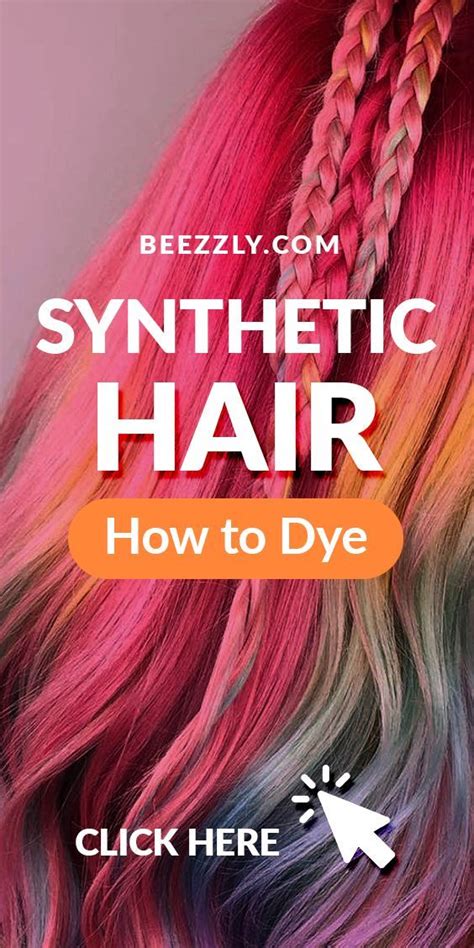Introduction
Synthetic hair dye has become increasingly popular in recent years, due to its wide range of colors, affordability, and ease of use. However, there are also some risks associated with using synthetic hair dye, such as allergic reactions and damage to the hair.

History of Synthetic Hair Dye
The first synthetic hair dye was developed in 1863 by a French chemist named Eugène Schueller. Schueller’s dye was based on a compound called paraphenylenediamine (PPD), which is still used in many hair dyes today.
In the early 1900s, synthetic hair dyes became widely available to the public. However, these early dyes were often harsh and damaging to the hair. In the 1950s, new and gentler synthetic hair dyes were developed, which made them more popular than ever before.
Today, synthetic hair dye is one of the most popular hair care products in the world. It is used by people of all ages and backgrounds to change the color of their hair.
Types of Synthetic Hair Dye
There are two main types of synthetic hair dye:
- Permanent hair dye is designed to permanently change the color of your hair. It contains a high concentration of ammonia, which opens up the hair shaft and allows the dye to penetrate deep into the hair.
- Semi-permanent hair dye is designed to last for 4-8 weeks. It contains a lower concentration of ammonia than permanent hair dye, and it does not penetrate as deeply into the hair shaft.
How to Use Synthetic Hair Dye
Synthetic hair dye is relatively easy to use. However, it is important to follow the instructions carefully to avoid any problems.
Here are the steps on how to use synthetic hair dye:
- Read the instructions carefully and make sure you understand them.
- Apply a small amount of dye to a patch of skin on your inner elbow. Wait 24 hours to see if you have any allergic reaction.
- If you do not have any allergic reaction, apply the dye to your hair according to the instructions.
- Leave the dye on for the amount of time specified in the instructions.
- Rinse the dye out of your hair with warm water.
- Style your hair as usual.
Benefits of Synthetic Hair Dye
Synthetic hair dye offers a number of benefits, including:
- Wide range of colors: Synthetic hair dye is available in a wide range of colors, from natural shades to bright and vibrant hues.
- Affordability: Synthetic hair dye is relatively affordable, compared to other hair coloring methods, such as professional hair coloring.
- Ease of use: Synthetic hair dye is easy to use at home. You do not need any special skills or equipment.
- Can be used to correct color mistakes: Synthetic hair dye can be used to correct color mistakes, such as brassy or orange tones.
- Can be used to create highlights and lowlights: Synthetic hair dye can be used to create highlights and lowlights, which can add depth and dimension to your hair.
Risks of Synthetic Hair Dye
There are also some risks associated with using synthetic hair dye, including:
- Allergic reactions: Some people are allergic to the ingredients in synthetic hair dye. This can cause a variety of symptoms, such as itching, redness, and swelling.
- Damage to the hair: Synthetic hair dye can damage the hair, especially if it is used frequently or if it is not used according to the instructions.
- Can cause hair loss: Synthetic hair dye can cause hair loss, especially if it is used frequently or if it is not used according to the instructions.
- Can be toxic: Some synthetic hair dyes contain harmful chemicals that can be toxic if they are absorbed through the skin or inhaled.
How to Choose the Right Synthetic Hair Dye
When choosing a synthetic hair dye, it is important to consider the following factors:
- Your hair type: Not all synthetic hair dyes are created equal. Some dyes are better suited for certain hair types than others. For example, permanent hair dye is not recommended for people with fine or damaged hair.
- The color you want: Synthetic hair dye is available in a wide range of colors. Choose a color that you like and that will complement your skin tone.
- The price: Synthetic hair dye is relatively affordable, but there is a range of prices available. Choose a dye that fits your budget.
- The reviews: Read reviews of different synthetic hair dyes before you buy one. This will help you to choose a dye that is effective and safe.
Conclusion
Synthetic hair dye is a popular and affordable way to change the color of your hair. However, it is important to be aware of the risks associated with using synthetic hair dye and to choose a dye that is right for your hair type and your needs.
